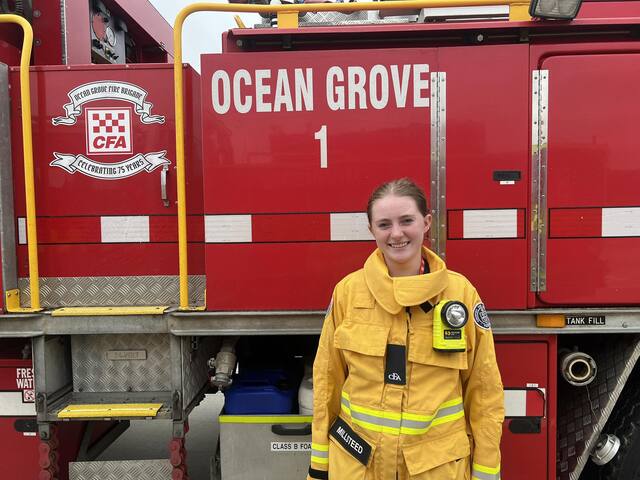There’s no doubt the ‘swim between the flags’ message has kept plenty of people safe when visiting one of the Bellarine or Surf Coast beaches patrolled by lifeguards and lifesavers.
But last summer, 54 people drowned in 90 days along the Australian coast. All of them occurred in unpatrolled locations, including 78 per cent on beaches.
Professor Rob Brander – aka Dr Rip – is a surf scientist with UNSW Sydney’s School of Biological, Earth and Environmental Sciences. He has studied the rip current hazard on beaches from both physical and social science perspectives for the past 30 years.
“We know from studies we’ve conducted that there are two primary reasons that people continue to swim at unpatrolled beaches – where there are no flags or lifesavers,” he said.
“The first is that the beach is the closest one to their holiday accommodation. The reality is that people don’t jump in their car and drive 20 minutes to the nearest patrolled beach.
“The second main reason is they actively choose beaches that are quiet and away from the holiday crowds.
“So while ‘swim between the flags’ is a great message and keeps us safe on patrolled beaches, we need to accept the fact that there are many popular and accessible unpatrolled beaches, and that people will always visit them.
“We don’t want to encourage people to swim at unpatrolled beaches, but we need to come up with some practical advice about how they can be safer when visiting them.”
Professor Brander points to the Surf Life Saving Association’s Think Line Campaign as a great start, and the organisation has started setting up emergency response beacons (ERBs) at beaches in NSW that allow people on the beach to communicate directly with the Surf Life Saving NSW State Operations Centre in an emergency.
“The Think Line is a simple concept that applies to any beach. You don’t cross the road without looking both ways, so when you first arrive at a beach you need to stop and think about beach safety and look for any hazards. You also need to have a plan if something goes wrong,” he said.
Ask yourself the following questions…
1. Are there any flags or lifeguards?
2. Did you see any signs saying beach closed or no lifeguard on duty?
3. What’s the surf like – are the waves too big for you?
4. Are you with people or alone? Are there other people on the beach?
5. Are there any floatation devices nearby – surfboards, boogie boards, a cooler or anything that floats?
6. Do you have mobile reception?
7. Is there an Emergency Response Beacon on the beach to alert emergency services?
8. Are you a strong swimmer?
9. Do you know how to spot a rip?
Professor Brander says your answers to these questions should give you a better sense of the type of risk you’re taking by swimming at an unpatrolled beach.
But there’s one scenario where Dr. Rip’s advice is much more forthright.
“If you’re alone on the beach, and there’s no one around, and you’re not a surfer or an experienced ocean swimmer, and you think it might be OK to go in the water – don’t,” he said.
“If you get stuck in a rip, there’s no one going to be able to save you. So if in doubt, don’t go out.”
How to spot a rip
What makes rips particularly dangerous is at first glance, many of them look like seemingly calm, darker patches of water.
Many people arrive at the beach and assume the darker, greener areas are the safest place to swim because there are no waves breaking there.
But the reality is that breaking waves and whitewater mean that it’s shallower and that whitewater is moving water onshore. Those darker, green gaps between the whitewater mean it’s deeper and could be rip currents that take you out to sea. One way to remember it is using the saying: white is nice, green is mean.
“The sad thing about rip currents,” says Professor Brander, “is they are potentially avoidable. But on average, 25 to 30 people tragically drown every year in Australia each year after being caught in rips. That’s more on average than the number of fatalities per year caused by cyclones, bushfires, floods and sharks combined. Rip currents are a big deal.
“The simple fact is, if you don’t get in a rip current, you won’t drown in one.”
So – ready to learn how to spot a rip? Here are the three different kinds of rip currents.
1. Channelised rips
The most common rip and the easiest to spot are the ones that sit in deep channels between shallow sandbars. These channelised rips look like dark gaps between areas of whitewater and breaking waves.
Channelised rips can be in the same place for days, weeks and even months, and are the easiest to spot. Generally, you don’t just get one channelised rip as they occur along the beach at varying intervals.
2. Boundary rips
Boundary rip currents are another common type of rip, that also usually occupy deeper channels, but they occur next to headlands, rock outcrops, or human-made structures like piers, jetties and groins. Water flowing along the beach will hit these rocky features or structures and will be deflected offshore.
Boundary rips can be almost permanent, in fact, we often give them names – such as the ‘Backpacker Express’ at Bondi in Sydney or the nearby ‘Bronte Express’. Surfers use boundary rips to get quickly out beyond the breakers, but swimmers can easily get into trouble if they get caught in them by swimming too close to the rocks.
“Some boundary rips are great for surfers who get a free ride out the back to catch waves, but they’re not good for swimmers, who may be fooled by the calmer looking waters,” Professor Brander says.
“In terms of safety on the beach, you really don’t want to be swimming anywhere near rocks, headlands, or structures.”
3. Flash rips
The final type of rip is a flash rip. These rips are different because they do not sit in deep channels and don’t look like dark gaps.
They’re also common, but occur quickly and don’t last long, which makes them hard to spot. Here’s some examples from Coogee Beach in Sydney and City Beach in Perth.
Dr Rip says flash rips are caused by some random large waves, or a set of larger waves that break, which makes them impossible to predict, and very difficult to study.
“Every now and then particularly when the waves are messy, you get a couple of big waves break, the water piles up and it pushes a rip current out called a flash rip. You’ll see the turbulent whitewater, you’ll see clouds of sand going out to sea and if anyone’s in that region, they can easily be caught and taken offshore.
“A flash rip may only last for a minute or so and then it disappears. But others can quickly develop elsewhere along the beach. They’re very difficult to spot because they form quickly and don’t last very long. So it’s something you should be aware of, and also remember they can also often form off the back of sandbars.”
What if I get caught in a rip?
Once you’re in water over your waist, the danger of being taken by a rip rises dramatically. You should always make sure your feet are firmly on the sand, particularly if you are not a good swimmer.
If you do find yourself caught in a rip, there are a few key things you should do.
1. Relax!
There’s a saying that ‘Rips don’t drown people, people drown in rips’. The main reason for that is many people panic when they realise they are caught in a rip. Panic is the real danger.
“You really don’t need to panic because rips are just taking you for a ride,” Professor Brander says.
“Rips don’t pull you under the water. That’s a myth – there’s no such thing as an undertow. They don’t take you across the ocean and they aren’t taking you into shark-infested waters. They’re just taking you for a ride and there’s a good chance they might re-circulate back into shallower water.”
2. Don’t swim against it
For most people when they get caught in a rip, their first instinct is to swim back to the safety of the beach.
“But that means you’re swimming against the rip, which is flowing very fast and probably faster than most people can swim,” Professor Brander says.
“Swimming against the rip will just tire you out and lead to panic.”
3. Float
The best thing to do when caught in a rip current is to float.
“If you relax and float, by treading water, or even lying on your back, you’re conserving your energy,” Professor Brander says.
“Eventually the rip will stop flowing, usually just beyond the breaking waves and often rips can re-circulate you around back into shallower water.”
The traditional advice has always been to swim parallel to the beach to escape a rip, but that only applies to strong swimmers and is complicated by the fact that not all rips flow straight offshore. It’s always better to float.
4. Signal for help
So you’re not panicking, you’re not swimming against the rip back to the beach and you’re floating. The next thing to do is to signal for help. Are there lifeguards, lifesavers, or surfers nearby? It’s time to raise your arm and wave it, or call out for help.
Surfers do a lot of rescues and they have a nice surfboard you can hold onto. So if you’re in trouble in a rip and there’s no lifeguards or lifesavers around, look for surfers and get their attention.
5. If there’s no-one else on the beach…
If you are caught in a rip and there’s nobody else around to help, then you really do have a big problem.
“As harsh as it sounds, you really shouldn’t have gone in the water in the first place,” Professor Brander says.
He says that in these cases, the best thing to do is to still float and stay calm, even if the rip has taken you out behind the breakers. There’s a good chance that someone will eventually see you.
“The other option is to swim along the beach a fair way and then back into shore. Look for areas where there are lots of waves breaking and aim for that.
“But that’s only if you are a strong swimmer, because it’s going to involve a long and hard swim.”
It really does come down to ‘If in doubt, don’t go out’.
Help! I need to rescue someone
Tragically, each year a significant number of people die trying to rescue others in distress on Australian beaches, often a family member or child.
A recent study found that in the 15-year period between 2004 and 2019, between four and five bystanders fatally drown while trying to rescue others in trouble.
The majority of them occurred on unpatrolled beaches.
“If you’re on the beach and you see someone in the water in distress and you want to go help them, there’s a number of important things you really need to think about,” Professor Brander says.
“Even if it’s your own child in trouble in the water, I cannot emphasise enough how important it is not to rush in. Don’t rush in. That person may not really know what’s going on, they may not even be panicking – but you might be.”
Avoid the instinct to sprint to the water and then swim as fast as you can to reach the person in trouble because by the time you reach that person, there’s a good chance you are already tired and exhausted.
“So please don’t rush in. You need to take some time – even just 10 seconds and think about what to do. You need to call for help, or get someone to go get help. There might be a lifeguard or lifesaver further down the beach, maybe there’s some surfers around, but get somebody to get help.
“And if you are going to go in the water, you must grab something that floats. Look around the beach, maybe there’s a boogie board lying around or a surfboard or ball, something that you can take with you if you’re going to go in because that gives you and the person you’re trying to rescue something to hold on to and that can make a difference.”
Dr Rip’s advice for bystander rescues
1. Don’t rush in.
2. Call for help if possible. Or get someone to go get help. There might be an Emergency Response Beacon on the beach.
3. Look on the beach for a floatation device or anything that floats. There might be public rescue equipment available. If you are going to go in the water, you must bring something that floats.
4. If you are going to go and help the person, don’t run or swim as fast as you can – you need to conserve energy.
5. When you get to the person, try and get them to stay calm. Assure them that all they have to do is float. If you brought one, use your floatation device to support them (and you).
6. When you get to the person, try and get them to stay calm. Assure them that all they have to do is float.
8. Wave for help, or if there’s nobody else around, try to slowly move yourself and the person you’re rescuing towards areas of breaking waves – this should indicate an area of shallower water and the breaking waves may assist you get back to shore.









